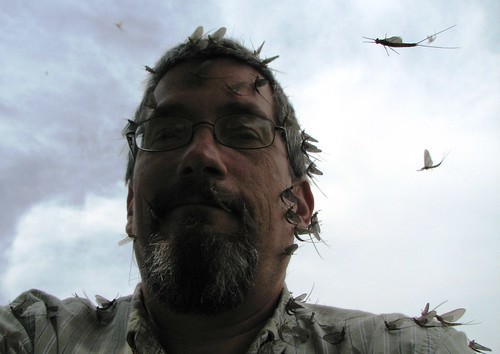 | |
| An adult mayfly. Image Source. |
A student in one of my classes rafted down the Mississippi River last summer, and made a movie about it. I don’t know much about the journey, and the film isn’t done yet, but as you might imagine, this is a student whose mental wheels are always in motion. In class last night, during a lecture-turned-conversation about population biology, she asked if I knew anything about the millions of insects that rose from the river, clouded the air for a few days, then disappeared. Mayflies, I said.
What I knew last night about mayflies will fill this short paragraph. They hatch all at once, they live as adults for a day or two, they mate, they lay eggs, they die. All of them at once.
After I described what I know about the life cycle of mayflies, another student asked the obvious: “What’s the point?”
If I were an ecologist, or an evolutionary biologist, or had just about any different credentials for teaching about populations and ecosystems than the ones I have, I might have had an easier answer, which might have involved an explanation of the genetic drive to pro-create. And if I were a little more new-agey in my professor persona, I might have appealed to an explanation about the nature of the life-force, the chi of the mayfly. But my intellectual training didn’t feed me either of these lines of argument. I scanned my brain for anything else I might possibly know about the Mayfly. I came up with this extra data:
They’re a bit bigger and bulkier than a dragon fly, but not pretty, brown with long transparent wings. I have an image from my childhood of a small clear lake in Michigan’s Upper Peninsula, its clean sandy bottom littered with millions of dead mayflies. That’s it.
Nope, I said, as far as I could tell, no point at all. A younger, more idealistic group of students might have been dismayed, even horrified, by this answer, and I might have spent the rest of the semester back-pedaling, apologetically trying to work the philosophy of It all in to the rest of the course, trying to demonstrate that the world isn’t a harsh careless no-point-at-all kind of place. But my students now are hard working-night-school-attending adults, and not afraid of harsh real-world answers. “nope, no point at all” was a perfectly satisfactory answer for most of them, and instead of dismay or despair on their faces I saw chuckles, sighs, acceptance. One student helpfully suggested: well I suppose they feed the fish and birds while they’re at it. I agreed.
But this morning I am left with the feeling of a good question not fully answered. So I Googled: Mayflies, meaning of life.
 |
| Image Source |
I was surprised, as I often am by Google, at how many hits this query produced. A fellow blogger finds the meaning of Mayfly life in getting them to transfer from a tree to himself.1
But I had to keep looking.
But I had to keep looking.
And I have learned a lot in the past hour. It all fills the next long paragraph.
The mayfly is not a single species, but an entire taxonomic Order called Ephemeroptera. Ephemeral, winged. Those taxonomists who came up with the name for this Order knew how to get to the heart of things. But mayflies actually go through multiple life stages, and only the final stage is ephemeral, and winged. The eggs hatch into nymphs, and some species go through as many as 28 separate nymphal stages. The nymphal stages can last up to four years. This starts to look like a pretty rich life. As nymphs, they can eat, swim, and be eaten. Some species burrow, others live under rocks. Doubtless if they wanted to, these nymphs could form meaningful bonds with other nymphs, could appreciate the beauty and peril and joys of their nymph-ness, looking forward to future life stages, including contemplating their species’ imperatives to swim or burrow or live under rocks, harboring envy or hatred or unrequited love for other species of nymphs. But it’s doubtful that they would want to. Another Google search -- Mayfly consciousness – does yield some interesting links to the possibility that honeybees have enough neural networks to be able to count 2. Not quite the level of self-awareness we have in mind if we want the Mayflies to find meaning in their lives. But certainly their brains are big enough for mayfly purposes. Importantly, their brains are sufficiently large and sophisticated that they can sense the perfect conditions for moving into the next phase of life, a collective urge strong enough to bring their selves to the water’s surface en masse, to become full-fledged full-winged adult mayflies, hungry for survival of the species.
I admit, I am a little less dismayed or horrified (idealistic youngster that I am) by the brevity and singularity of purpose of their short adult lives. Even though it is unlikely, these nymphal stages comfort that part of my imagination that wants there to be more to it . If the Mayfly’s life has any meaning for us, it may be simply that while the end goal is vitally important for survival, the rich, multi-phased nymphal processes of getting there are where it’s at.
Julie...you must come to the campground for the Mayfly hatch this summer....it's quite something and you're the only one I know who would appreciate it! GAB
ReplyDelete